We’re all familiar with mitochondria, right? These are the so-called power plants of our cells, producing most of the body’s energy with the help of oxygen. Yet, what many people don’t realize is that mitochondria function as the gatekeepers of cell life and cell death [1].
Yes, mitochondria are absolutely essential for life due to their role in energy production, but they also influence cell signaling, regulate cell death processes, impact cellular redox balance, and house important biosynthetic pathways [2]. Our mitochondria essentially function in two modes: the life-giving energy production mode, and the death-inducing danger mode.
The default state of mitochondria is to produce energy and other important molecules that communicate a state of safety, resource abundance, and prosperity. However, when your mitochondria are damaged, they enter into a “danger mode” and release signaling molecules that cause inflammation and may ultimately lead to cell death [3].
In other words, the health of your mitochondria will determine whether they are producing energy or calling for help. They can’t do both.
Here’s an analogy to help illustrate this point: Your mitochondria are people within a cellular city working tirelessly to support its infrastructure and benefit civilization as a whole. But when the city is under siege and being damaged by things like oxidative stress, your people stop going to work and focus on the city’s defense.
One of the primary determinants of whether mitochondria switch from energy mode to danger mode is the integrity of their membranes. Similar to how city walls need to be strong for its people to feel safe, damage to mitochondrial membranes signals danger and a need to shift resources away from energy production.
My goal with this article is to share with you one of the most powerful supplements for repairing damaged mitochondrial membranes and shifting mitochondria from “danger” mode to “energy” mode. This supplement is a unique phospholipid complex called NTFactor®.
Lipid Replacement Therapy — How to Repair Your Mitochondrial Membranes
The idea that you can take a supplement containing cell membrane phospholipids to repair damaged mitochondrial membranes that accumulate through life and as a result of various pathologies is called lipid replacement therapy [4].
However, to accomplish such a feat requires a compound that can survive degradation during digestion and avoid oxidation during transport throughout the body. Yet, most sources of phospholipids are lecithin preparations that lack protection from oxidation and enzymatic destruction.
NTFactor® is a phospholipid complex that supplies the primary cell membrane phospholipids along with antioxidants and fructooligosaccharides to protect the phospholipids from enzymatic degradation and oxidation [4]. This phospholipid complex is absorbed relatively intact and readily transported throughout the body.
The result is a supply of bioactive phospholipids that naturally replace damaged mitochondrial membrane components, leading to a regeneration of dysfunctional mitochondria.
For example, in a study of older adults with mild-to-moderate fatigue, 2–3 grams per day of NTFactor® improved mitochondrial function by 24% after 12 weeks, restoring it to a level similar to healthy 29 year-olds [5]. This improvement in mitochondrial function was accompanied by a 33% reduction in self-reported levels of fatigue.
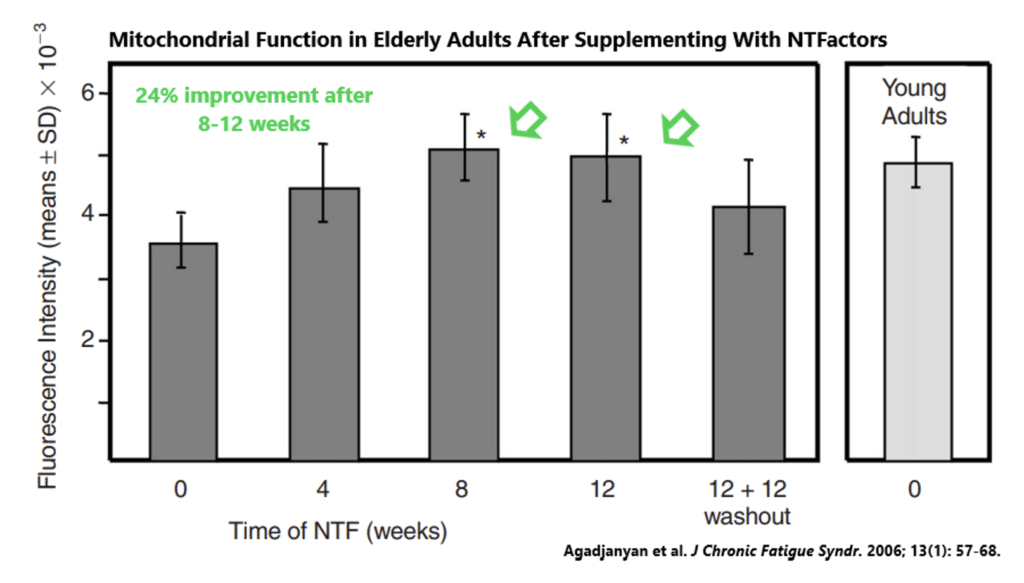
The improvements in fatigue with restoration of mitochondrial function shouldn’t be surprising. Remember, mitochondria can’t produce energy when damaged and in danger mode. By restoring the integrity of the mitochondrial membrane, NTFactor® is able to increase energy production and the energy levels of those using it.
NTFactor® Dramatically Increases Energy Levels and Reduces Fatigue
There is a pretty clear link between poor mitochondrial function and chronic fatigue syndrome. In one analysis of 132 adults with mitochondrial diseases, one third had severe or very severe fatigue, one third had moderate fatigue, and a quarter had mild fatigue — a very similar profile to those with chronic fatigue syndrome [6].
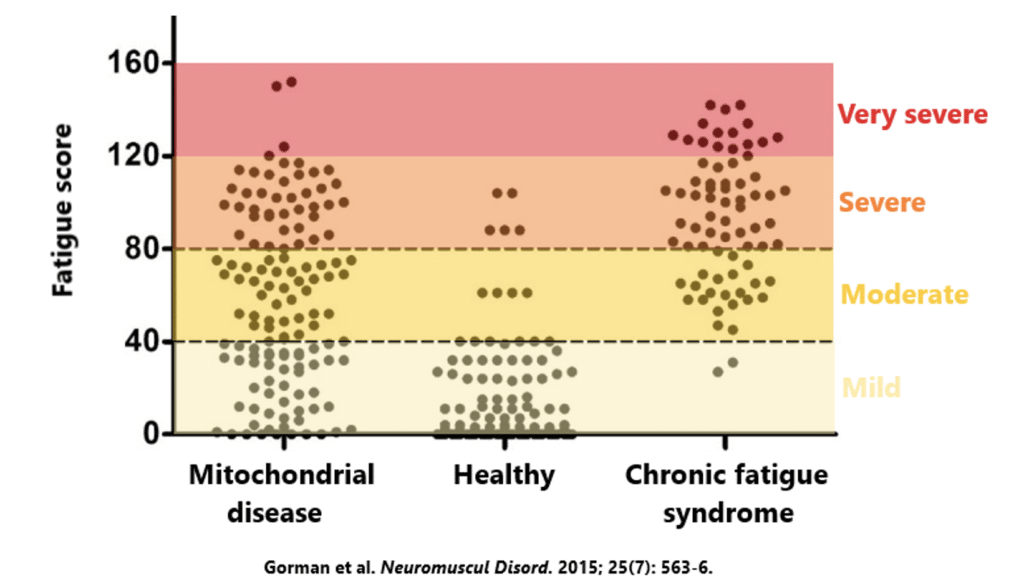
We also have a systematic review of 25 studies investigating the link between mitochondrial function and fatigue in people with chronic fatigue or other disease states in which fatigue is commonly present [7]. There were consistent associations between fatigue syndromes and mitochondrial dysfunction, including:
- Deficits in carnitine, which is required to transport fat into mitochondria for use as an energy source
- Deficits in coenzyme Q10, which is required to produce energy.
- Lower concentrations of antioxidants and higher levels of oxidative stress.
- Lower rates of ATP (cellular energy) production.
- Reduced gene expression in functional pathways for energy production, such as those related to metabolism, protein transport, and mitochondrial morphology.
By restoring the integrity of the mitochondrial membrane, NTFactor® is able to increase energy production and the energy levels of those using it. Numerous studies have shown that supplementing with 1.5–3 grams of NTFactor® reduces fatigue by 24–43% among those with chronic fatigue syndrome or conditions associated with fatigue, like general aging, obesity, lyme disease, and Gulf War Illness [8].
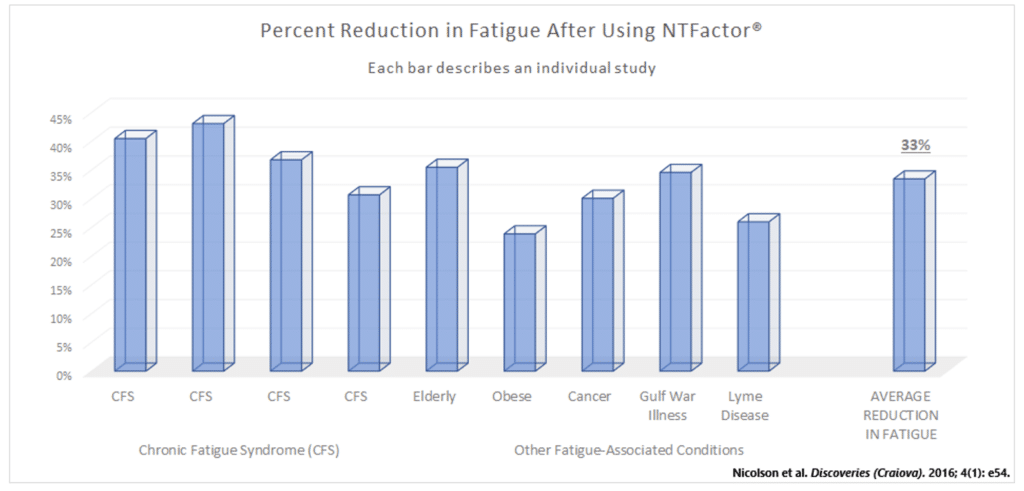
Summary
When your mitochondrial membranes are damaged, the mitochondria shift from “energy” mode to “danger” mode. When this happens, they divert resources away from producing energy and towards protecting themselves. The result is more fatigue and worse metabolic health.
Yet, your body has the ability to repair mitochondria if you give it the tools it needs. One of those tools is NTFactor® phospholipid complex, which could cut your fatigue by an average of 33%!
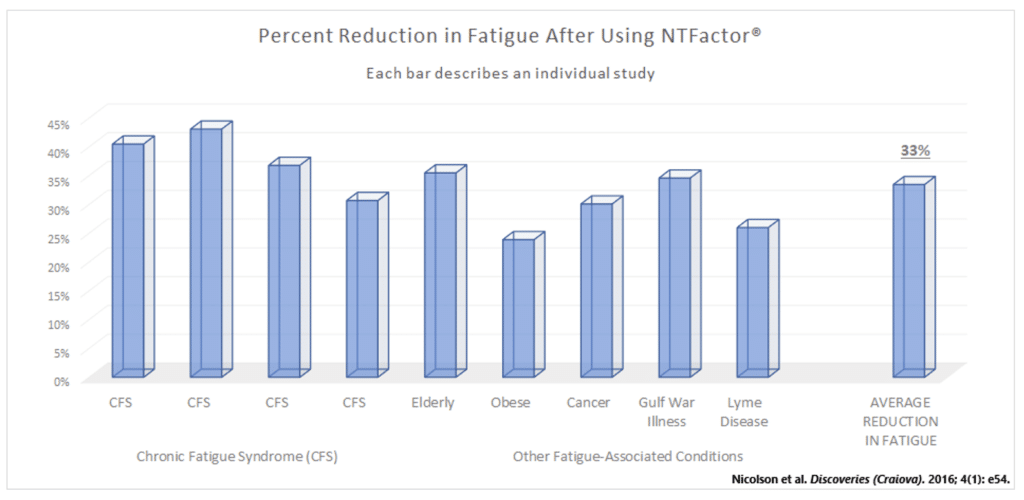
The science overwhelmingly shows that NTFactor® is a powerful mitochondrial rejuvenator and one of the most potent ingredients for sustainable, long-lasting energy enhancement. That is why we’ve made it one of the cornerstone ingredients in our mitochondrial energy formula, Energenesis.
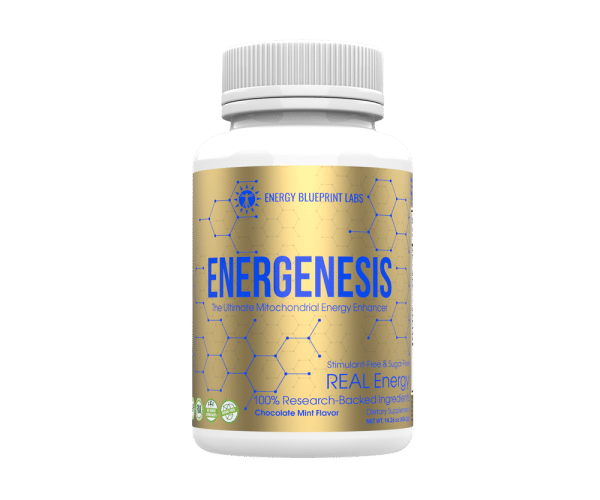
References
- Galluzzi L, Kepp O, Trojel-Hansen C, Kroemer G. Mitochondrial control of cellular life, stress, and death. Circ Res. 2012;111:1198–207.
- Duchen MR, Szabadkai G. Roles of mitochondria in human disease. Essays Biochem. 2010;47:115–37.
- Grazioli S, Pugin J. Mitochondrial Damage-Associated Molecular Patterns: From Inflammatory Signaling to Human Diseases. Front Immunol. 2018;9:832.
- Nicolson GL, Ash ME. Lipid Replacement Therapy: a natural medicine approach to replacing damaged lipids in cellular membranes and organelles and restoring function. Biochim Biophys Acta. 2014;1838:1657–79.
- Agadjanyan M, Vasilevko V, Ghochikyan A, Berns P, Kesslak P, Settineri RA, et al. Nutritional Supplement (NT FactorTM) Restores Mitochondrial Function and Reduces Moderately Severe Fatigue in Aged Subjects. J Chronic Fatigue Syndr. Taylor & Francis; 2003;11:23–36.
- 6. Gorman GS, Elson JL, Newman J, Payne B, McFarland R, Newton JL, et al. Perceived fatigue is highly prevalent and debilitating in patients with mitochondrial disease. Neuromuscul Disord. 2015;25:563–6.
- Filler K, Lyon D, Bennett J, McCain N, Elswick R, Lukkahatai N, et al. Association of Mitochondrial Dysfunction and Fatigue: A Review of the Literature. BBA Clin. 2014;1:12–23.
- Nicolson GL, Rosenblatt S, de Mattos GF, Settineri R, Breeding PC, Ellithorpe RR, et al. Clinical Uses of Membrane Lipid Replacement Supplements in Restoring Membrane Function and Reducing Fatigue in Chronic Diseases and Cancer. Discoveries (Craiova). 201




